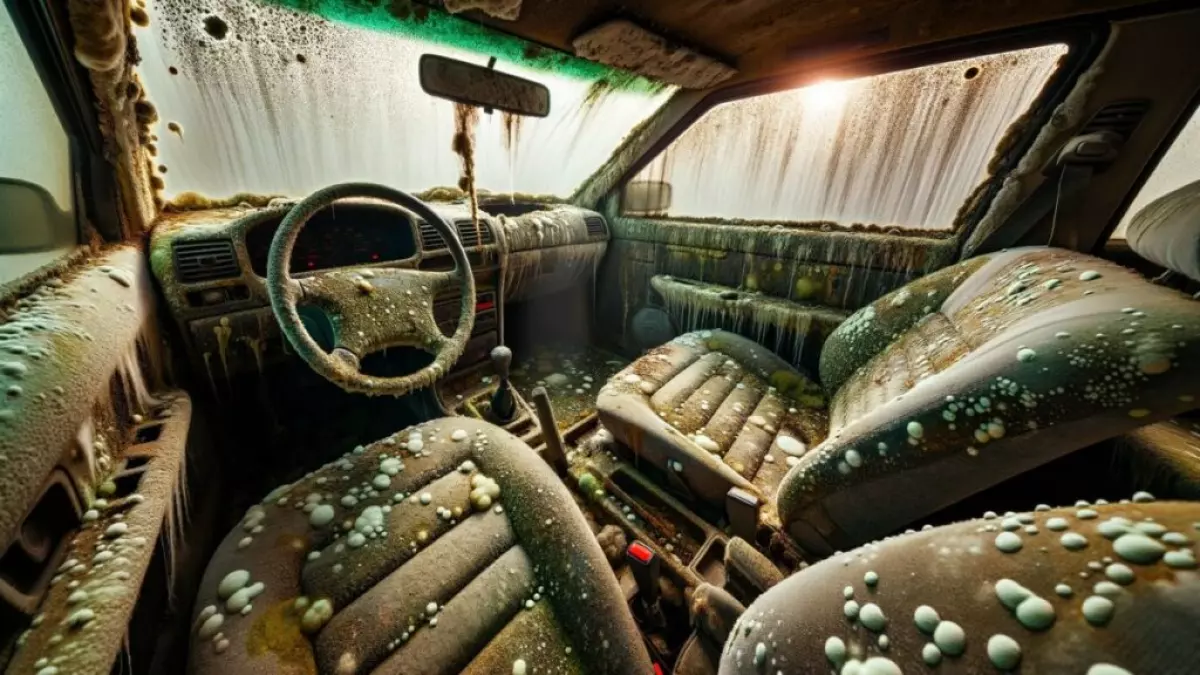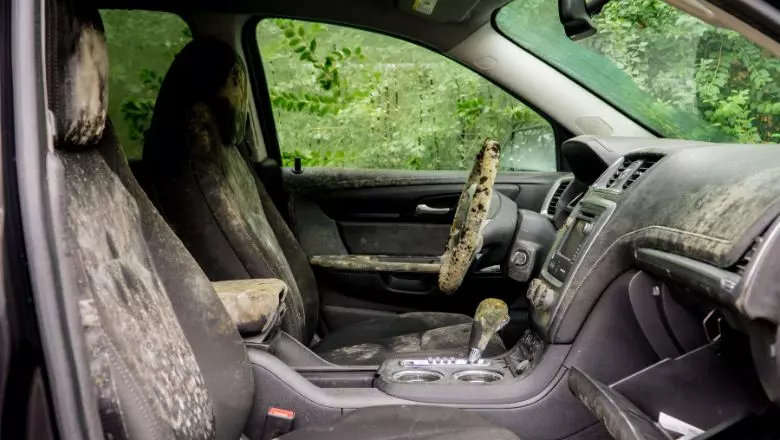 Photo Caption: Moldy car interior
Photo Caption: Moldy car interior
I hope you never have to deal with mold inside your car, but if you do, fret not! I've got you covered with this comprehensive guide on how to clean mold out of a car. Over the years, I've perfected these steps, ensuring a spotless result every time.
How to Clean Mold Out of a Car?
Here are the steps I follow when facing a moldy car interior:
-
Prepare a Mold Remover Solution: Mix vinegar with water and soda to create a powerful mold remover solution.
-
Spray and Wait: Apply the solution onto the mold-infested areas and let it sit for 10-15 minutes. This will help kill the mold.
-
Scrub Away: Use a clean cloth or sponge to scrub the surfaces thoroughly. Make sure to remove any residue.
-
Wipe Clean: Finish by wiping the area with a damp cloth to eliminate any remaining mold and solution residue.
 Photo Caption: Hydrogen peroxide
Photo Caption: Hydrogen peroxide
3 Great Mold Removers You Can Use As Well
If you don't have vinegar, water, or soda on hand, here are three alternative mold removers you can try:
1. Hydrogen Peroxide
- Mix 1 part hydrogen peroxide (3% concentration) with 2 parts water in a spray bottle.
- Spray the solution onto the mold-infested areas.
- Allow it to sit for 10-15 minutes to kill the mold.
- Scrub the surfaces with a clean cloth or sponge.
- Wipe the area to remove any residue.
2. Tea Tree Oil
 Photo Caption: Tea tree oil for cleaning mold
Photo Caption: Tea tree oil for cleaning mold
Tea tree oil is known for its antifungal properties and can be an effective solution for mold removal. Here's how to use it:
- Mix 2-3 teaspoons of tea tree oil with 2 cups of water in a spray bottle.
- Shake the bottle well for proper mixing.
- Spray the tea tree oil solution onto the affected areas and let it sit for a few hours.
- Wipe the interior surfaces with a soft, damp cloth to remove any remaining mold and tea tree oil residue.
3. Commercial Mold Removers
There are several commercial mold removers available on the market. One highly recommended option is the Star Brite Professional Mold & Mildew Stain Remover. Remember to follow the manufacturer's recommendations and ensure proper ventilation when using these products.
Safety Precautions When Cleaning
Before diving into the cleaning process, it's essential to take safety precautions:
- Ensure proper ventilation by opening the car windows or working in a well-ventilated area.
- Wear a mask, protective gloves, and safety goggles to avoid potential health risks from exposure to mold spores.
- In severe cases or if the mold covers a large area, it's advisable to seek professional help to ensure proper and thorough removal.
 Photo Caption: Car full of mold
Photo Caption: Car full of mold
Importance of Cleaning Mold From Your Car ASAP
Cleaning mold from your car is not just about appearances; it's crucial for several reasons:
-
Health Hazards: Mold can severely impact health, especially for individuals with respiratory issues, allergies, or compromised immune systems. Exposure to mold spores can lead to coughing, sneezing, eye and throat irritation, and even respiratory infections.
-
Unpleasant Odors: Mold growth brings a musty, disagreeable odor, which can be more pronounced in confined spaces like cars.
-
Damage to Car Interior: Mold can leave lasting stains, discoloration, and weaken fabrics and materials, leading to expensive repairs.
-
Structural Integrity Risks: If mold spreads to essential components like the dashboard or seats, it can compromise their structural integrity.
-
Resale Value Impact: A mold-infested car is less appealing to potential buyers and may indicate neglect and hidden issues.
Therefore, treating mold in your car should be a priority to protect both your health and your vehicle's value and condition.
What Causes Mold in Cars?
Understanding the primary causes of mold in cars can help prevent and address this issue effectively:
-
Moisture Accumulation: Excessive humidity, water leaks, wet clothing, or carpets inside the car are the main sources of moisture that promote mold growth. Spilled liquids and condensation from temperature differences can also contribute to moisture buildup.
-
Inadequate Ventilation: Poor airflow within the car traps moisture, creating an environment ideal for mold. Blocked air vents, malfunctioning air conditioning systems, or excessive use of the air recirculation setting contribute to poor ventilation.
-
Neglecting Spills and Leaks: Ignoring or delaying the cleanup of spills and leaks in the car provides the perfect breeding ground for mold.
By taking proactive measures like regular maintenance and promptly addressing moisture issues, you can significantly reduce the risk of mold in your car.
How to Prevent Future Mold Growth?
After successfully cleaning the mold from your car, it's crucial to take preventive measures to keep mold at bay:
-
Regular Cleaning: Regularly clean and vacuum your car's interior to remove any potential mold food sources and prevent moisture buildup.
-
Monitor Humidity Levels: Use a dehumidifier in your car during humid weather or park it in a cool, dry place.
-
Quickly Address Spills and Leaks: Promptly clean and dry any spills or leaks that occur in your car to prevent mold growth.
Remember, prevention is better than cure when it comes to mold in your car.
FAQ
If you have any questions about cleaning mold from your car, here are some frequently asked questions:
-
Can I use bleach to clean mold from my car? It's not recommended as bleach can damage car surfaces and release harmful fumes. Stick to the mold removers mentioned in this guide.
-
Is it safe to drive a car with mold inside? It's best to clean the mold promptly to ensure a safe and healthy driving environment.
-
Can I prevent mold growth by parking my car in direct sunlight? While sunlight can help reduce moisture, it's not a foolproof method to prevent mold. Proper ventilation and regular maintenance are essential.
-
How often should I clean my car's interior to prevent mold? Cleaning your car's interior at least once every few months and addressing any spills or leaks promptly will help prevent mold growth.
By following these guidelines and taking preventive measures, you can ensure a mold-free and fresh-smelling car interior.












